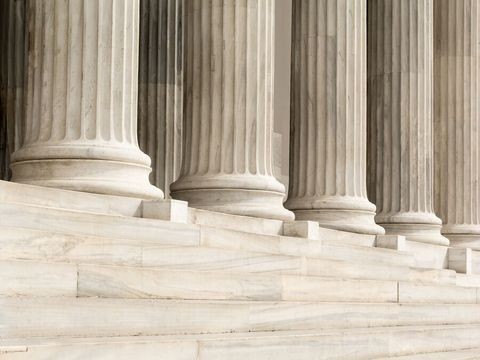Department of Energy Issues Second Request For Information (RFI) on Proposed Changes to its Appliance Standards Program
Client Alert | 4 min read | 12.08.17
For the second time in a week, the U.S. Department of Energy requested comments on its ongoing efforts to redesign the energy conservation standards program for appliances and other commercial and industrial products. The first RFI asked for input on a proposal for the possible replacement of the existing compliance and enforcement regime with a more market-oriented program. The second RFI, issued on November 28, 2017, seeks input on reforms in appliance standard development and test procedures used to assess companies’ compliance. As DOE moves forward with its plans to reshape the energy conservation standards program, it is important for manufacturers and importers of appliances and other affected products to understand how their businesses may be impacted, and to protect their interests by participating in the DOE rulemaking process.
The Energy Policy and Conservation Act (EPCA) requires DOE to set minimum energy conservation standards for a wide variety of products (“covered products”) and to establish test procedures for assessing compliance with those standards. Manufacturers and importers must annually test their covered products, and certify that those products meet their respective minimum efficiency requirements. As currently administered, EPCA requires DOE to reexamine existing standards for over sixty categories of covered products, and the test procedures for each standard, at least every six years, which has led to a program with essentially non-stop rulemaking.
The Second RFI solicits feedback on specific issues that relate to the agency’s process for promulgating standards and test procedures, and also seeks input on other revisions to that process. DOE’s proposed changes include:
- Establishing energy conservation standards through negotiated rulemaking, which would allow the agency to develop a rule in consultation with interested parties.
- Instituting additional means for soliciting feedback from industry prior to initiating the rulemaking process.
- Using established industry standards for compliance testing.
- Requiring that test procedures are issued prior to the issuance of the energy conservation standards themselves.
Highlights of the Second RFI
- Direct Final Rules – EPCA allows DOE to establish energy conservation standards by direct final rule (DFR). Seldom used in the past, this provision allows DOE to fast-track traditional rulemaking and issue a final rule “[o]n receipt of a statement by interested parties that are fairly representative of relevant points of view . . . as determined by the Secretary [of Energy].” The DFR, once issued, would be open to public comment for at least 110 days, with the agency having discretion to withdraw the DFR 120 days after issuance if there is “a reasonable basis” (determined by the Secretary) for doing so. While subject to judicial review, this type of rulemaking would significantly streamline traditional Administrative Procedure Act processes. The RFI could signal DOE’s desire to depart from the multi-year stakeholder process that has been part of EPCA rulemakings for decades.
- Adopting Industry Standards for DOE Test Procedures – DOE seeks comment on whether it should adopt established industry test standards, without modification, to conduct product testing. There are several at times differing test procedures in the regulations for covered products, some of which apply to DOE compliance and others that apply to manufacturer product certifications or annual manufacturer testing. These differing protocols present compliance challenges for regulated companies, testing companies, and DOE.
- Energy Savings Thresholds - Because standards must be reconsidered every six years and EPCA’s anti-backsliding provision means DOE cannot loosen a standard without Congressional authorization, DOE has at times ratcheted up standards that produced only marginal energy savings. The Second RFI asks whether DOE should consider establishing a threshold for the amount of energy savings necessary to justify the adoption of a revised energy conservation standard. If the energy savings from a proposed standard are below that threshold, the adoption of the standard would not be economically justified. DOE also proposes adding express “criteria for ‘no amended standards’ determinations when supported by data and when small energy savings require significant upfront costs to achieve.”
Action Items
The two RFI’s are the first comprehensive proposals to reform the energy conservation program in 30 years and together signal DOE’s intention to move quickly on its reform efforts. Once published in the Federal Register (expected within a week), commenters will have 90 days to comment on the Second RFI. DOE is also hosting a public meeting regarding the Second RFI on January 9, 2017. The Second RFI is an opportunity for manufacturers, importers and interested parties to give feedback to the agency as to how its rulemaking procedures might be revised so as to improve efficiency and provide companies with flexibility and certainty. Interested parties should consider submitting comments in both RFI dockets and attending the meeting with DOE on January 9.
Contacts
Insights
Client Alert | 5 min read | 12.12.25
Eleventh Circuit Hears Argument on False Claims Act Qui Tam Constitutionality
On the morning of December 12, 2025, the Eleventh Circuit heard argument in United States ex rel. Zafirov v. Florida Medical Associates, LLC, et al., No. 24-13581 (11th Cir. 2025). This case concerns the constitutionality of the False Claims Act (FCA) qui tam provisions and a groundbreaking September 2024 opinion in which the United States District Court for the Middle District of Florida held that the FCA’s qui tam provisions were unconstitutional under Article II. See United States ex rel. Zafirov v. Fla. Med. Assocs., LLC, 751 F. Supp. 3d 1293 (M.D. Fla. 2024). That decision, penned by District Judge Kathryn Kimball Mizelle, was the first success story for a legal theory that has been gaining steam ever since Justices Thomas, Barrett, and Kavanaugh indicated they would be willing to consider arguments about the constitutionality of the qui tam provisions in U.S. ex rel. Polansky v. Exec. Health Res., 599 U.S. 419 (2023). In her opinion, Judge Mizelle held (1) qui tam relators are officers of the U.S. who must be appointed under the Appointments Clause; and (2) historical practice treating qui tam and similar relators as less than “officers” for constitutional purposes was not enough to save the qui tam provisions from the fundamental Article II infirmity the court identified. That ruling was appealed and, after full briefing, including by the government and a bevy of amici, the litigants stepped up to the plate this morning for oral argument.
Client Alert | 8 min read | 12.11.25
Director Squires Revamps the Workings of the U.S. Patent Office
Client Alert | 8 min read | 12.10.25
Creativity You Can Use: CJEU Clarifies Copyright for Applied Art
Client Alert | 4 min read | 12.10.25
Federal Court Strikes Down Interior Order Suspending Wind Energy Development



